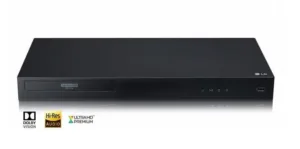The day started out as a trip to a local furniture store to replace a couch our cats had largely destroyed by using it as a scratching post, along with two reclining lounge chairs. This, in anticipation of a spring kitchen and family room remodeling, which is long overdue.

A year ago, I upgraded my main television to an LG OLED55C9, and love it. LCD TVs have come a long way since their debut 15 years ago, but to my eyes, nothing compares to a calibrated emissive display. My Panasonic FHD plasma was retired a few years back due to excessive power consumption, and an extra 47-inch LG FHD LCD TV (Super IPS, of course) took its place until I could find something better.
Having some time to kill last March (like all of us), I was able to procure a color sensor, test pattern generator, and CalMan software from the gracious folks at Portrait Displays, and do a complete calibration of my set. Actually, I should clarify: My part of the job was to connect the sensor to a tripod, put it up against the screen, drape the screen in black velvet, connect the pattern generator to my laptop and also connect to the 55C9 through an Internet connection to access its internal LUTs.
The rest was “set it and forget it.” I started the CalMan program and went into the kitchen to have lunch. When I returned, the calibration in ISF Daytime Mode was done. Piece of cake! Since then, we’ve watched a mishmash of 720p, 1080i, and 1080p content on the LG, with the rare streaming 4K program from Amazon Prime and Netflix (in HDR, of course).
Streaming Dents Optical Media
There’s no question that streaming video put a major dent in sales and rentals of optical disc media: Thanks to the explosive growth of streaming services and digital downloads, coupled with ever-faster broadband to the home, the popularity of BD players has declined dramatically. Only a handful of companies still manufacture them. Among the brands are Sony, LG, and Panasonic. Samsung bailed on the format a couple of years ago, as did Pioneer and Oppo. (Sony’s PlayStation 5 also supports the UltraHD BD format.)
But a funny thing happened during the pandemic: Sales of BD players started to pick up, as did sales of discs. People were also checking them out of libraries and borrowing from neighbors. Dusty boxes of BD players suddenly disappeared from store shelves. (Hey; when you’re stuck at home with children, you have to keep them occupied somehow – right?) Those trends coincided with a spike in sales of 65-inch and larger Ultra HDTVs, which were up 30% in the fall of 2020 Y-Y.
Since the local Best Buy (BB) was just down the street from the furniture store (and I was really curious to see just how good 4K versions of Dunkirk and the BBC’s Planet Earth II looked on the 55C9), and also having attended CES for years and returned each year with a pile of Blu-ray discs – among them, about a dozen Ultra HD discs – I decided to splurge and pick up an LG UBK90. It helped that Best Buy had it marked down $100 to $199, too.
A Waste of Time
First, let me say that ordering online for pickup at the store was a waste of time. I got to BB nearly 3 hours after making my online purchase, and it still wasn’t ready for pickup. Nor could any store associate illuminate me as to how to speed up the process. So, I strapped on my Covid mask, strode through the doors, and located the aisle with BD players, finding two UBK90s ready and waiting. (As of this writing, there’s still one in stock!) I got in line and after a wait of about 15 minutes, checked out with my prize.
Connecting the UBK90 to the 55C9 took some thought. The 55C9 has 4 HDMI 2.0 ports and one doubles as an audio return channel (ARC) port for an external AV receiver or soundbar. I decided to use that connection, through my Yamaha sound bar, to get into the TV. I powered everything up, loaded a 4K disc of Dunkirk, and stepped back to watch; warning my wife that it could get loud, and it did! (Note that the UBK90 has two separate HDMI output connections – the second is audio-only, for hookup to an AV receiver or soundbar, and is unidirectional.)
Picture Quality – Astounding!
To say the picture quality was astounding is an understatement. Considering that Ultra HD BD discs use variable bit rate (VBR) encoding but typically run in the 100 Mb/s peak range, I was quite impressed. In HDR, the colors popped, and the specular highlights from waves during the bomber attack scene sparkled. HDR really came into play in another scene of several British soldiers stuck in the hull of a beached fishing boat – you could see amazing shadow detail and bright shafts of light from bullet holes at the same time.
Then, the trouble started. The picture would disappear, followed by the appearance of a 4K HDR logo in the upper right corner of the screen, and then the return of the movie. This happened repeatedly but erratically with several discs, and the only thing I can deduce is a compatibility issue with ARC through the Yamaha’s HDMI connection. Putting the UBK90 on its own dedicated HDMI input to the TV and connecting my more-vanilla TiVo OTA Bolt to that Yamaha HDMI port finally solved the problem.
I’ve long believed that the best nature videographers in the world work for the BBC. I wasn’t disappointed with Planet Earth II in 4K with HDR. This is flat-out some of the best footage you’ll ever see out of a movie theater; in particular, low-light and low-contrast footage of caves and snow-capped peaks in the fog. The Islands program really showed off the wider ITU BT.2020 color gamut associated with HDR – the sea was a rich blue; red and yellow flowers really popped, and the greens on chameleons looked radioactive.
More Disks?
Do I plan on buying more 4K UHD discs? Not likely, as there’s so much to watch via streaming channels and the flow of content will only increase. Maybe I’ll pick up some classic films with good 4K transfers, like Universal’s Back to The Future trilogy. Given the spike in BD sales1 and rentals, studios have furiously been transferring and mastering new Full HD and 4K versions of their libraries, so I’ll have lots of choices.
But once Internet connections can sustain data rates in the 100 Mb/s range using the HEVC H.265 codec (and once next-generation codecs like VVC become widely adopted), I think the days of optical media will be numbered, save for hard-core collectors. The diminished number of BD player manufacturers indicates I’m not alone. – PP
1Recent data from the CTA said that over the year, all optical formats fell in sales over the year in North America, so the spike was short-lived. (ED)

